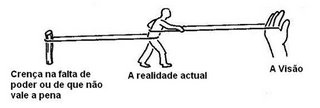Depois, ainda na mesma página, escreve algo muito pouco português: “Vision becomes a living force only when people truly believe they can shape their future. The simple fact is that most managers do not experience that they are contributing to creating their current reality. So they don’t see how they can contribute toward changing that reality. Their problems are created by somebody “out there” or by “the system”.
Ao desenhar, ao descrever um estado futuro desejado, a Visão; e ao confrontá-lo com a situação actual, identificamos uma lacuna. Essa lacuna, segundo Senge, cria uma tensão criativa, capaz de gerar a energia criativa necessária à acção, para mudar a organização e transformá-la na organização descrita na visão.
No livro “The Heart of change”, John Kotter também se refere ao papel da Visão:
Página 1
“People change what they do less because they are given analysis that shifts their thinking than because they are shown a truth that influences their feelings” (Agostinho da Silva dizia o mesmo, com outras palavras)
Página 3
“To understand why some organizations are leaping into the future more successfully than others, you need first to see the flow of effective large-scale change efforts. In almost all cases, there is a flow, a set of eight steps that few people handle well.”
Página 7
Step 1. Increase urgency (a mudança não é para se ir fazendo, é para fazer!!!); Step 2. Build the guiding team; Step 3. Get the vision right; Step 4. Communicate for buy-in; Step 5. Empower action; Step 6. Create short-term wins; Step 7. Don’t let up; Step 8. Make change stick.
Página 68
“In cases of successful large-scale change, you find four elements that help direct action: budgets, plans, strategies, and visions. All four are different yet tightly interrelated, and each requires a different development process.
A budget is the financial piece of the plan. A plan specifies step by step how to implement a strategy. A strategy shows how to achieve a vision. A vision shows an end state where all the plans and strategies will eventually take you.”
Assim, um Balanced Scorecard da 3ª geração usa a criação de uma Visão, uma descrição do ponto de chegada, como o ponto de partida para a escolha dos objectivos estratégicos, dos indicadores e metas.
A Visão funciona como o nosso paradigma do futuro, ao cruzarmos esse paradigma com a realidade actual, identificamos as lacunas que têm de ser preenchidas. As lacunas serão eliminadas pelo desenvolvimento e implementação de iniciativas estratégicas. O mapa da estratégia continua a ser a descrição de como vamos satisfazer os clientes-alvo.


%2006.21.jpeg)













Sem comentários:
Enviar um comentário